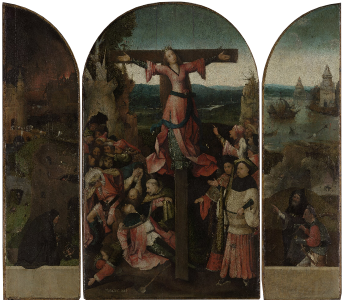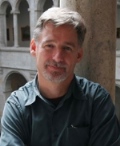Queen's professor immersed in groundbreaking art conservation project
June 25, 2013
Share
By Wanda Praamsma, Communications Officer
 Queen's in the World
Queen's in the WorldQueen’s Professor Ron Spronk (Art History) is currently absorbed in a groundbreaking art conservation project that is using ultrahigh-resolution macro photography, X-rays and infrared light to examine the works of Dutch painter Jheronimus Bosch. The 15th-century artist is renowned for his complex panoramic triptychs and fantastic imagery.
Since 2010, Dr. Spronk has been an instrumental player in the Bosch Research and Conservation Project (BRCP), an international, interdisciplinary team of scholars, scientists and art conservators that is studying, documenting and conserving Bosch’s paintings. The team is preparing an exhibition for 2016, the 500th anniversary of Bosch’s death, in ‘s-Hertogenbosch, The Netherlands, the painter’s birthplace and home.
 Overall view of Bosch's Triptych of St. Uncumber.
Overall view of Bosch's Triptych of St. Uncumber.The project marks the first time in history that an entire oeuvre – 30 paintings spread over many different collections in Europe and North America – is being documented and examined in a standardized way, always using the same equipment and procedures. With this documentation, Dr. Spronk explains, “scholars will finally be able to compare apples to apples, rather than the photographs of these apples.”
"This project is more challenging, and more fun, than anything I’ve done before because of its complex nature,” says Dr. Spronk, a specialist in the technical examination of paintings. “It’s such a privilege – because of the equipment and expertise available to us, we reach a level of intimacy with the artist and the artwork that was not possible before. We are looking not only at the painted surface but also what’s below, to the underdrawing and the earlier paint layers, all the layers of work that come before.”
All Bosch’s artworks, which were painted on wood panels, not cloth, are being documented through ultrahigh-resolution macro photography in visible and infrared light, which allows researchers to look through the paintings, down to the original sketch. The images are then stitched together to allow careful, microscopic examination.
Through this process, the team has discovered major differences in the ways the works were designed and produced, determining that there were many people working on the paintings – not just Bosch.
 A detailed image from the left wing of the Triptych of St. Uncumber using infrared reflectography. More images at boschproject.org
A detailed image from the left wing of the Triptych of St. Uncumber using infrared reflectography. More images at boschproject.org“In a medieval workshop the work was often divided between the master, his assistants, and journeymen. But Bosch also came from a family of painters, and he could have collaborated with no less than nine members of his family. The idea of a single individual genius painter having executed all these famous works is not sustainable anymore,” says Dr. Spronk, who also teaches part-time at Radboud University in Nijmegen, The Netherlands.
The project is also unique because the team works on location, in the various world museums where Bosch’s paintings are housed. Dr. Spronk will soon join his counterparts in Madrid, at the Museo Nacional del Prado, to document and examine the famous Haywain triptych there. And in September, a member of the team will start restoring several works in Venice, including the Hermit Saints Triptych, the Triptych of St. Uncumber, and the Four Visions of the Hereafter, together with Italian colleagues.
 Dr. Ron Spronk
Dr. Ron SpronkWorking with Dr. Spronk on the collaborative Bosch project are scholars and scientists from the United States and The Netherlands. The project was initiated by the Jheronimus Bosch 500 Foundation, the Noordbrabants Museum and Radboud University, and is supported by Queen’s, the Stichting Restauratie Atelier Limburg, and the University of Arizona.
The Queen’s News Centre will follow Dr. Spronk’s progress with the project and provide additional updates as he moves toward the finale exhibition at the Noordbrabants Museum in ‘s-Hertogenbosch in December 2015 and early 2016. In the meantime, visit the project website to view extraordinary images of the Bosch research.